ACOMP: The Automated System that allows Continuous Realtime Monitoring of Polymerization Reactions
Abstract ACOMP (Automatic Continuous Online Monitoring of Polymerization Reactions) is a patented product from Fluence Analytics that continuously monitors and characterizes polymers during polymerization or post-polymerization processing steps of laboratory or industrial scale polymer reactions. Beyond allowing the user to monitor polymerization reactions in real time, ACOMP enables the user an ability to control specific desired polymer characteristics. His eventual goal was to analyze the evolution of these macromolecular processes in real-time, and in the process, he developed a methodology capable of studying many polymerization techniques such as free radical, controlled radical, solution, bulk and emulsion during synthesis. Over the following 20 plus years, a multitude of government and industrially funded research projects and collaborations have led to over 90 invited lectures and over 40 peer review publications. Additionally, there have been 10 issued and 25 pending patents around the space of polymerization monitoring and control. Today, ACOMP, as offered by Fluence Analytics, is a completely automated solution which allows for tighter process control, resulting in increased polymer yield, increased polymer quality and consistency, increased worker safety, reduced cycle time, reduced VOCs and reduced energy and raw material usage. Rather than placing probes directly into the polymerization reactor or slip streams, ACOMP continuously extracts a small stream of reactor contents during the process (typically 0.10-1.0 cm3/minute). Next, the extracted stream is immediately diluted and homogenized, through proprietary sample handling technology, with an appropriate solvent halting further polymerization. The conditioned stream of diluted polymer passes through a detector train which enables real-time characterization of many polymerization processes. The detectors, of which any or all may be used, are comprised of Ultra-Violet/Visible Absorption (UV/Vis), Differential Refractometer (DRI), dilute solution single capillary viscometer (Visc) and multi-angle light scattering (MALS), and others. The appropriate configuration of detectors is selected according to the desired polymer properties and chemistry to be monitored. The subsequent data are then used to calculate the Weight Average Molecular Weight (Mw), Intrinsic Viscosity (IV), monomer conversion kinetics, residual monomers, co-monomer composition and drift, and other polymer properties traditionally measured through discrete, off-line analysis. Theoretical Framework Raw UV, Viscometer and Light Scattering Signals Figure 3 displays typical raw ACOMP signals versus time for the free radical polymerization of acrylamide. A monomer baseline is collected for all detectors prior to initiating the polymerization which is indicative of the known reactor conditions before any signal changes due to the effects of polymerization. Monomer and Polymer Concentration Intrinsic Viscosity and Molecular Weight Since monomer concentration decreases throughout the reaction, longer polymer chains are produced at the beginning of the reaction, and chain lengths diminish as the reaction proceeds. The ability to monitor the cumulative weight average molecular weight and polymer concentration also allows for the calculation of Instantaneous Weight Average Molecular Weight, Mw,inst. The Mw,inst measures the molecular weight of chains being produced at any instant, whereas the cumulative molecular weight applies to all the polymer chains produced up to any instant. Using these data, Fluence Analytics has developed a method for building “chromatography-free molecular weight distributions” by building the final distribution from the evolution of the instantaneous molecular weight throughout the reaction. ACOMP Advantage for Polymerization Reactions Data handling and advanced computational analysis packages have been developed to convert the continuous stream of ACOMP data into the critical information desired by the user. ACOMP’s advantage is derived from direct polymer characterization continually taking place in real time, therefore, offering the capability of live feedback control. These challenges, along with maintenance requirements, can make it difficult to adopt SEC directly to a rapidly changing industrial reaction process. ACOMP permits the continuous, realtime characterization of the polymer’s absolute molecular weight, conversion of monomer, and intrinsic viscosity allowing for better monitoring and predictability of product characteristics. This translates to further control of the outcome of the polymerization process.
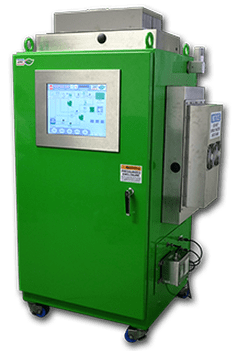
During the 1980s Professor Wayne Reed, Fluence Analytics CSO, began laying the research foundation with his work in light scattering to characterize macromolecules while working at the Physics Department at Tulane University.
This technical note will explain how ACOMP functions as well as some of the measurable benefits gained from utilizing the ACOMP technique.ACOMP Principle
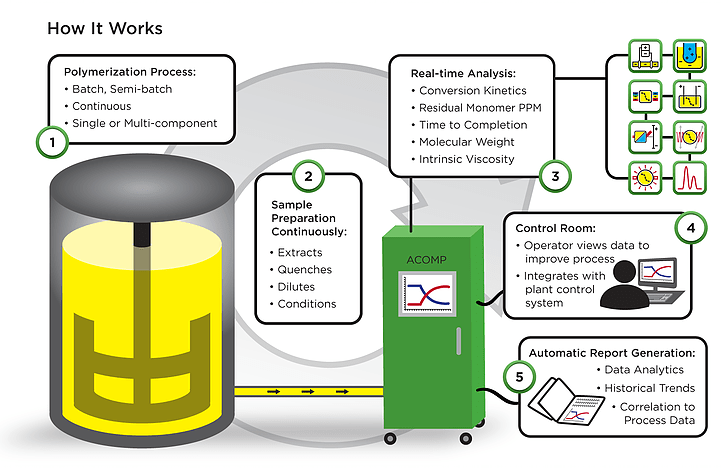
Fluence Analytics can tailor ACOMP to pair with many detectors through a selection of modules. As noted, Fluence Analytics offers ACOMP with UV/Vis, DRI, Visc. and MALS. Other detectors that can be utilized in ACOMP include conductivity, pH, Oxygen sensing and near-infrared.
The UV/Vis detector uses multiple wavelengths whose selection is based on the evaluation of the absorption spectra of the monomer, polymer and solvent. By monitoring the absorption of UV light for specific wavelengths throughout the polymerization process, ACOMP can determine the monomer concentration and polymer conversion as well as actively predict, the total amount of residual monomer concentration.
The DRI detector is used to determine the total concentration of monomer and polymer in the sample stream.
Intrinsic Viscosity as measured by the Viscometer is a measure of both the hydrodynamic volume and molar mass of a polymer and can be correlated to the polymer’s architecture and rheological properties. The intrinsic viscosity information can then be used to determine correlations related to the degree of polymer branching, crosslinking and shear thinning.
The Fluence Analytics built MALS detector is specifically designed for ACOMP use and utilizes multi-angle Zimm extrapolation in conjunction with polymer concentration to characterize the weight average molecular weight of the polymer sample throughout polymerization reactions. This information can be used to directly show the evolving molecular weight of the product as a function of time or polymer concentration.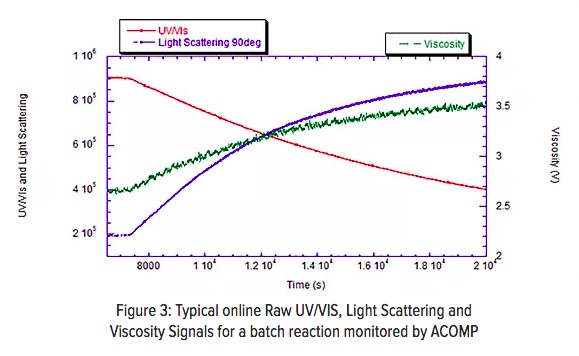 The signal in red represents the UV Absorption versus time and is a direct measure of the monomer concentration throughout the polymerization. Subsequently, polymer concentration is calculated from monomer concentration through a simple mass balance. Also shown in figure 3 are 90-degree light scattering signature from the MALS detector and the raw voltage signal from the Viscosity detector. These detectors are molar mass sensitive and as result, increase throughout the polymerization as the size and concentration of the polymer increase. They are used to calculate the weight average molecular weight and intrinsic viscosity, respectively.
The signal in red represents the UV Absorption versus time and is a direct measure of the monomer concentration throughout the polymerization. Subsequently, polymer concentration is calculated from monomer concentration through a simple mass balance. Also shown in figure 3 are 90-degree light scattering signature from the MALS detector and the raw voltage signal from the Viscosity detector. These detectors are molar mass sensitive and as result, increase throughout the polymerization as the size and concentration of the polymer increase. They are used to calculate the weight average molecular weight and intrinsic viscosity, respectively.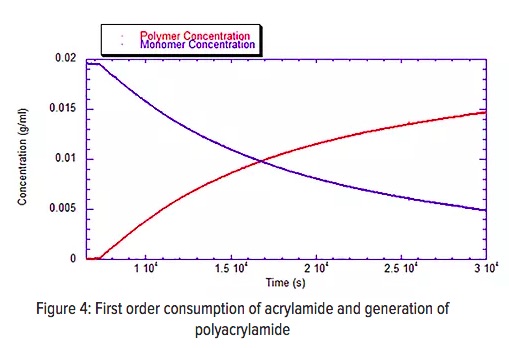
Figure 4 shows the calculated evolution of monomer and polymer concentrations throughout the polymerization. The consumption of monomer in a free radical polymerization follows first-order kinetics as the monomer double bonds form polymer bonds. Fluence Analytics has utilized this continuous data to develop a monomer prediction algorithm that can predict residual monomer concentration beyond the direct sensitivity of the UV/Vis detector. The results of this algorithm have been thoroughly cross-checked and confirmed via High Performance Liquid Chromatography (HPLC).
As the polymer concentration is determined in realtime, the weight average Molecular Weight Mw and Intrinsic Viscosity are correspondingly calculated. Figure 5 shows the IV and Mw for a free radical polymerization, where the kinetic chain length is proportional to the monomer concentration.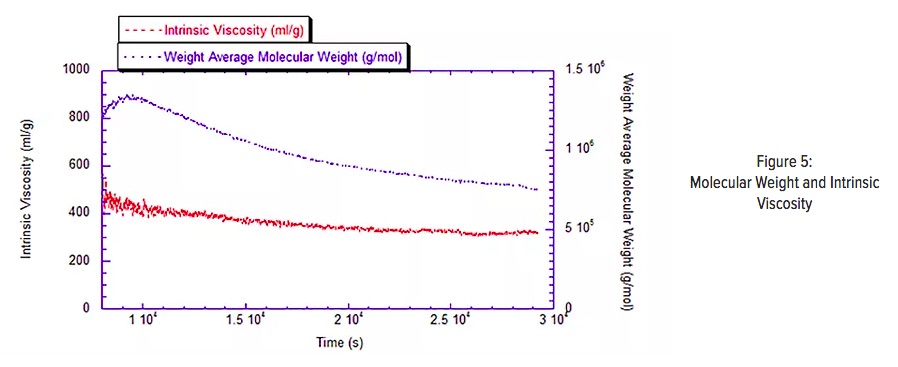
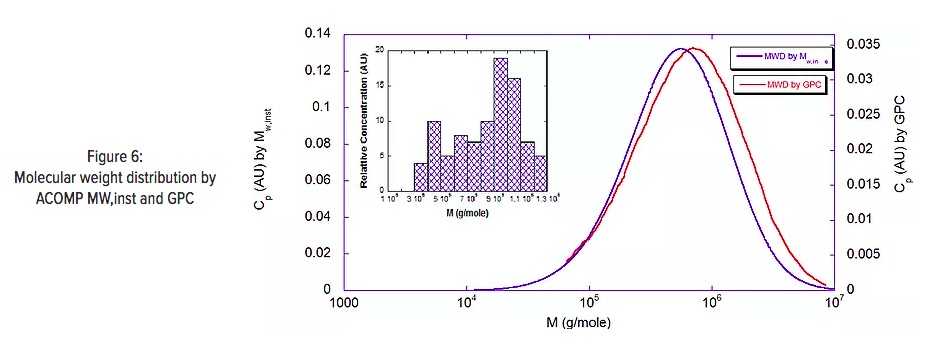
A major feature of ACOMP is the fully integrated and automated platform providing continuous, realtime analysis of polymer properties. This unique platform leverages the latest automation, sensor and detector technologies connected by a sophisticated hardware and software automation package.
Additionally, ACOMP has the ability to characterize the polymer without using size exclusion chromatography (SEC). While the SEC process is a valuable, post-production method of characterization, it inherently creates a delay from sample collection to process critical result and only provides discrete data at specified intervals. This leaves gaps in what is usually valuable reaction kinetic and material property evolution data during synthesis.
Lab ACOMP
Lab ACOMP is available for laboratory and pilot scale polymerization reactions independently or customized to attach to, and monitor, pre-existing laboratory and/or pilot reactor systems. The ACOMP can also integrate with most standard control interfaces used by the laboratory or pilot reactors.
Industrial ACOMP
The Industrial ACOMP is a robust monitoring system designed for production-scale polymerization reactions and can be tailored for numerous applications from a standardized set of modules.
The first Industrial ACOMP has been in service monitoring a batch specialty polymer process for more than two years with an overall availability greater than 97%. This availability is achieved by the use of more than 100 self-monitoring sensors coupled with automated corrective action procedures that engage as a result of any unplanned operating anomalies such as changes in system pressures. The Industrial ACOMP is designed in a NEMA 4X enclosure and can be rated for up to a Class I Division II plant environment. Class I Division I (explosion proof) environments can be considered with enclosure customization.
The ACOMP data are available to operators, plant managers, QA/QC personnel, process chemists and managers through the plant Distributed Control System (DCS).
Furthermore, ACOMP is capable of sending automated e-mail reports on each production batch or a specified period of time. These data can provide insights into Golden Batch information, the series of conditions that will yield on-spec product in the shortest amount of time, eliminate failed reactions, reduce grade change over time and off-spec product, and reduce batch cycle time and emissions.
Conclusion
Fluence Analytics’s ACOMP is the ONLY fully automatic, smart manufacturing system which enables the continuous, realtime monitoring and characterization of polymerization reactions during synthesis. Current characterization methods rely on off-line, single point characterization techniques which create significant information gaps throughout a reaction process. These industry standard techniques work very well for analyzing end products, but do not yield critical kinetic and property evolution information that is only available from ACOMP.
With this ACOMP enabled direct reaction monitoring capability, the next steps are being taken to include process optimization and fully automated reaction control. These continuous, realtime data can be fully integrated with control systems and other data analysis tools, thus creating another opportunity for long-term data mining and multi-site, coordinated product optimization. Finally, this level of control can enable tailored polymeric materials with customized properties and applications for individual customers.
For further reading about ACOMP:
Reed, W.F. “Automated Continuous Online Monitoring of Polymerization Reactions (ACOMP) and Related Techniques.” Encyclopedia of Analytical Chemistry, 2013, 1-40, DOI: 10.1002/9780470027318.a9288.
Alb, A. M.; Reed, W. F. “Fundamental Measurements in Online Polymerization Reaction Monitoring and Control with a Focus on ACOMP”, Macromolecular Reaction Engineering, 2010, 4(8), 470-485, DOI: 10.1002/mren.200900079

